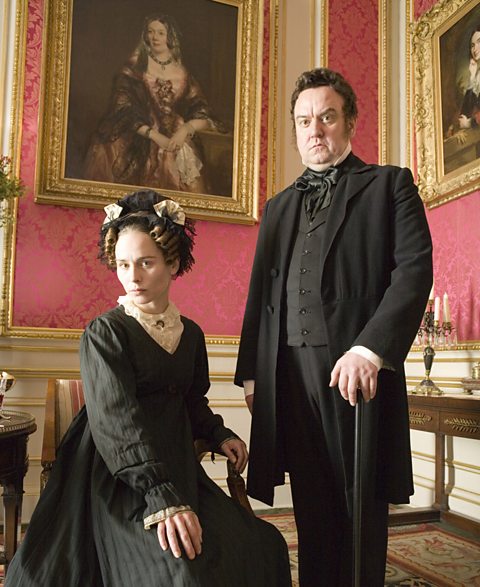Love and hate in Jane Eyre
In Jane Eyre Brontë deals with love and how characters respond to this emotion. Throughout the novel, the reader learns the true value of love - how it can benefit others, how Jane responds to love and how it develops her as a person. Equally, Brontë shows the other side of love, which is hate, and what this can do to individuals.
Love and hate are binary opposites, meaning that the two emotions are the complete opposite.

The emotions of love and hate are primarily shown through the characters Jane meets and has a relationship with. In Jane's childhood, for example, her aunt and her family are described as detesting Jane, physically and emotionally abusing her on several occasions.
When Jane moves to Lowood, Mr Brocklehurst is also cruel towards Jane. However, it is through the character of Helen Burns that Jane understands what love and friendship mean.
Question
How are the binary opposites of love and hate shown in the novel?
Love:
- Jane's first friend, Helen Burns
- the love she feels for Mr Rochester
- the love she feels for her family, the Rivers
Hate:
- the way the Reed family responds to Jane
- the way Mr Brocklehurst treats Jane
- Bertha's hatred towards Rochester
| How is this shown in the novel? | Evidence | Analysis | |
| Hate - the Reed Family | From the beginning of the novel, the reader learns that the Reed family are cruel towards Jane. They do not treat her as family and tell her she is not wanted. | John Reed is vicious towards Jane and taunts her: "You have no business to take our books; you are a dependent, mama says; you have no money; your father left you none; you ought to beg, and not to live here with gentleman's children like us." | John explicitly says that Jane should not be living with them, reflecting what his mother believes. The repetition of the personal pronoun 'you' illustrates John's hatred for Jane and highlights the difference between her and them. |
| Love - Helen Burns | When Jane moves to Lowood School she makes her first friend. The reader learns that Jane loves Helen and enjoys the friendship they have. | This is shown when Jane seeks solace in Helen: 'Resting my head on Helen's shoulder, I put my arms round her waist; she drew me to her, and we reposed in silence.' | Jane is comfortable in Helen's presence and she finds peace with Helen. This extract highlights their true friendship, as Helen 'drew' Jane into her - making them closer and loving. |
| Hate - Bertha | During the run-up to Jane's marriage to Rochester, Bertha escapes from her attic and stamps on Jane's wedding veil. | Bertha stamps on Jane's wedding veil in the middle of the night: "Sir, it removed my veil from its gaunt head, rent it in two parts, and flinging both on the floor, trampled on them." | The use of the verbs 'flinging' and 'trampled' highlight Bertha's viciousness, as she wanted to damage the wedding veil. The trampling of the wedding veil also predicts Jane's future. Her dreams of marrying Rochester will be trampled on. |
| Hate - the Reed Family | |
|---|---|
| How is this shown in the novel? | From the beginning of the novel, the reader learns that the Reed family are cruel towards Jane. They do not treat her as family and tell her she is not wanted. |
| Evidence | John Reed is vicious towards Jane and taunts her: "You have no business to take our books; you are a dependent, mama says; you have no money; your father left you none; you ought to beg, and not to live here with gentleman's children like us." |
| Analysis | John explicitly says that Jane should not be living with them, reflecting what his mother believes. The repetition of the personal pronoun 'you' illustrates John's hatred for Jane and highlights the difference between her and them. |
| Love - Helen Burns | |
|---|---|
| How is this shown in the novel? | When Jane moves to Lowood School she makes her first friend. The reader learns that Jane loves Helen and enjoys the friendship they have. |
| Evidence | This is shown when Jane seeks solace in Helen: 'Resting my head on Helen's shoulder, I put my arms round her waist; she drew me to her, and we reposed in silence.' |
| Analysis | Jane is comfortable in Helen's presence and she finds peace with Helen. This extract highlights their true friendship, as Helen 'drew' Jane into her - making them closer and loving. |
| Hate - Bertha | |
|---|---|
| How is this shown in the novel? | During the run-up to Jane's marriage to Rochester, Bertha escapes from her attic and stamps on Jane's wedding veil. |
| Evidence | Bertha stamps on Jane's wedding veil in the middle of the night: "Sir, it removed my veil from its gaunt head, rent it in two parts, and flinging both on the floor, trampled on them." |
| Analysis | The use of the verbs 'flinging' and 'trampled' highlight Bertha's viciousness, as she wanted to damage the wedding veil. The trampling of the wedding veil also predicts Jane's future. Her dreams of marrying Rochester will be trampled on. |
Question
How does the binary opposite of love and hate link to the novel's form, a bildungsroman?
- It is through Jane's experiences with love and hate that she learns and moves forward in her life - vowing not to make the same mistakes again.
- It is through Jane's experiences with love and hate that she develops into the woman she is at the end of the novel.